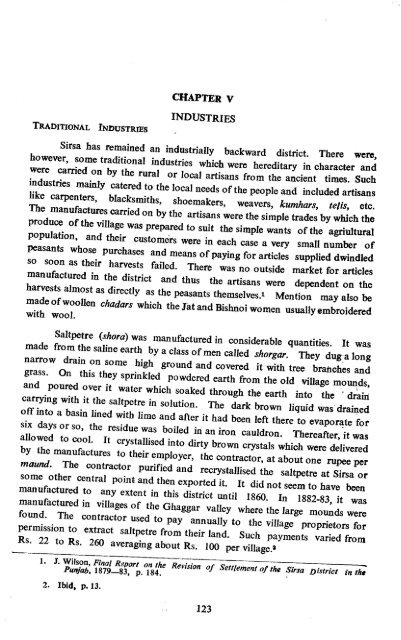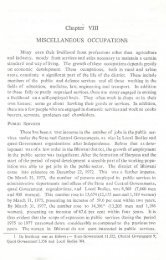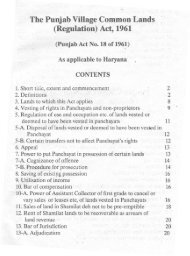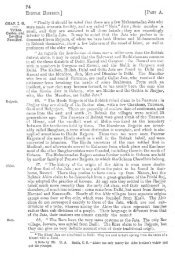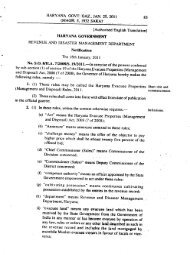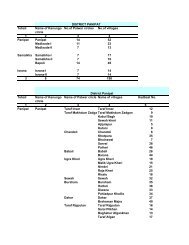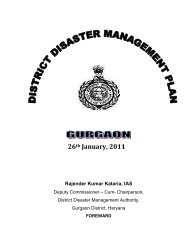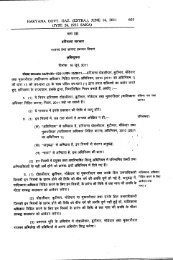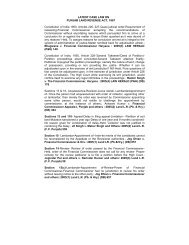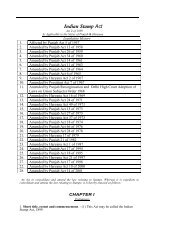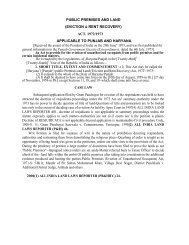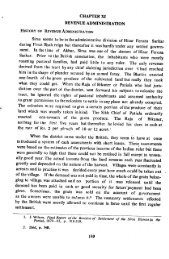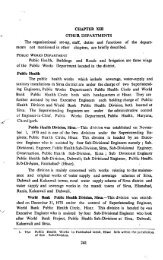CHAPTER V INDUSTRIES Sirsa has remained an industrially ...
CHAPTER V INDUSTRIES Sirsa has remained an industrially ...
CHAPTER V INDUSTRIES Sirsa has remained an industrially ...
You also want an ePaper? Increase the reach of your titles
YUMPU automatically turns print PDFs into web optimized ePapers that Google loves.
<strong>CHAPTER</strong> V<br />
<strong>INDUSTRIES</strong><br />
<strong>Sirsa</strong> <strong>has</strong> <strong>remained</strong> <strong>an</strong> <strong>industrially</strong> backward district. There were,<br />
however, some traditional industries which were hereditary in character <strong>an</strong>d<br />
were carried on by the rural or local artis<strong>an</strong>s from the <strong>an</strong>cient times. Such<br />
industries mainly catered to the local needs of the people <strong>an</strong>d included artis<strong>an</strong>s<br />
like carpenters, blacksmiths, shoemakers, weavers, kumhars, telis, etc.<br />
The m<strong>an</strong>ufactures carried on by the artis<strong>an</strong>s were the simple trades by which the<br />
produce of the village was prepared to suit the simple w<strong>an</strong>ts of the agriultural<br />
population, <strong>an</strong>d their customers were in each case a very small number of<br />
peas<strong>an</strong>ts whose purc<strong>has</strong>es <strong>an</strong>d me<strong>an</strong>s of paying for articles supplied dwindled<br />
so soon as their harvests failed. There was no outside market for articles<br />
m<strong>an</strong>ufactured in the district <strong>an</strong>d thus the artis<strong>an</strong>s were dependent on the<br />
harvests almost as directly as the peas<strong>an</strong>ts themselves. 1 Mention may also be<br />
made of woollen chadars which the Jilt <strong>an</strong>d Bishnoi women usually embroidered<br />
with wool.<br />
Saltpetre (shora) was m<strong>an</strong>ufactured in considerable qu<strong>an</strong>tities. It was<br />
made from the saline earth by a class of men called shorgar. They dug:a long<br />
narrow drain on some high ground <strong>an</strong>d covered it with tree br<strong>an</strong>ches <strong>an</strong>d<br />
grass. On this they sprinkled powdered earth from the old 'Villagemoun,ds,<br />
<strong>an</strong>d poured over it water which soaked through the earth into the . dram<br />
carrying with it the saltpetre in solution. The dark brown liquid was drai~ed<br />
off into a basin lined with lime <strong>an</strong>d after it had been left there to evapora;te for<br />
six days or so, the residue was boiled in <strong>an</strong> iron cauldron. Thereafter, it was<br />
allowed to cool. It crystallised into dirty brown crystals which were delivered<br />
by the m<strong>an</strong>ufactures to their employer, the contractor, at about one rupee per<br />
maund. The contractor purified <strong>an</strong>d recrystallised the saltpetre at <strong>Sirsa</strong> or<br />
some other central point <strong>an</strong>d then exported it. It did not seem to have been<br />
m<strong>an</strong>ufactured to <strong>an</strong>y extent in this district until 1860. In 1882-83, it was<br />
m<strong>an</strong>ufactured in villages of the Ghaggar valley where the large mounds were<br />
found. The contractor used to pay <strong>an</strong>nually to the village proprietors for<br />
permission to extract saltpetre from their l<strong>an</strong>d. Such payments varied from<br />
Rs. 22 to Rs. 260 averaging about Rs. 100 per village.s<br />
1. J. Wilson, Filial Report on the Revision of Settlement of the <strong>Sirsa</strong> District in the<br />
Punjab, 1879-83, p. 184. .<br />
2. Ibid. p. 13.
The district <strong>remained</strong> <strong>industrially</strong> backward mainly due to unfavourable """<br />
geographical conditions, lack of communications <strong>an</strong>d scarcity of basic raw<br />
materials. However, by 1916, three cotton ginning factories had been<br />
established at M<strong>an</strong>di Dabwali besides a railway locomotive workshop at<br />
Slfsa.1 The setting up of cotton ginning factories further encouraged the<br />
production of cotton in the area <strong>an</strong>d also served as <strong>an</strong> impetus f()r industrial<br />
development.<br />
" In 1947, the number of small-scale industrial units in the district was<br />
only 9 with <strong>an</strong> investment of Rs. 64 thous<strong>an</strong>d <strong>an</strong>d providing t-~loyment<br />
to 16 persons. There was, however, no large scale industrial unit. During<br />
the period from 1947to 1966, the number of small-scale iRdustrial.units ~t up<br />
was 107 with <strong>an</strong> investment of Rs. 1.6 crore <strong>an</strong>d providing employmetlt<br />
to 1,37.8 persons. During the period from 1966 to 1976, the number of such<br />
units set up was 290 with <strong>an</strong> investment of Rs. 3.13 crore <strong>an</strong>d !,£oviding<br />
employment to 2,327 persons. In March 1981, there were 1,160 small-scale<br />
units. with a capital investment of Rs. 6.80 crore providing. employrn,ent to<br />
6,232 persons. Besides, there was a considerable number of uRits~hich were<br />
not registered .<br />
. Large alld medium scale units came into existence in the district only<br />
during sixties. In 1966, there were two such units. However, in 1980~81,<br />
their number rose to five out of which two units were in the co-operative<br />
sector. These units produced goods \yorth Rs. 7.50 crore approximately <strong>an</strong>d<br />
provided employment to 1,572 persons. .<br />
A detailed account of all the categories of industries, i.e. large <strong>an</strong>d<br />
medium-scale, small-scale <strong>an</strong>d the village <strong>an</strong>d cottage industries is given'<br />
hereafter:<br />
Lar-ge <strong>an</strong>d medium-scale units are engaged in the pi'lduction of cotton<br />
'--<br />
.yarn, oil <strong>an</strong>d solvent oil extraction, cotton ginning <strong>an</strong>d pressing, media<br />
craft paper <strong>an</strong>d milk chilling. A brief description of each large <strong>an</strong>d medium<br />
scale industrial unit is given below:<br />
Gopi Ch<strong>an</strong>d Textile Mills, <strong>Sirsa</strong>.-The mill went into production in 1967<br />
with a capacity of 12,096 spindles which rose to 18,592 spindles in 1976. Its<br />
installed capacity was further increased to 21,200 spindles in 1978. In ".<br />
1980-81, its production was worth Rs. 540 lakh <strong>an</strong>d it gave employment to<br />
1,292 persons.<br />
B.G. Fin<strong>an</strong>ce <strong>an</strong>d Industries Ltd., <strong>Sirsa</strong>.-The unit started production in<br />
1966. The unit <strong>has</strong> 12 oil expellers for crushing of cotton seeds, 52 kohlus
for crushing of mustard seed!!"<strong>an</strong>,da solvent extraction pl<strong>an</strong>t. The cotton<br />
seed, groundnut <strong>an</strong>d rice br<strong>an</strong> extractions are exported to foreign markets.<br />
Its exports during 1980-81 were to the tune of Rs. 1.60 crore. In 1980-81,<br />
its production was worth .Rs. 3.50 crore <strong>an</strong>d it gave employment to 85 persons ..<br />
Bared Cotton Ginning <strong>an</strong>d: Pressillg Factory, Ding.-It is a co-operative<br />
sector enterprise, owned <strong>an</strong>d run by the Hary<strong>an</strong>a Co-operative Marketing<br />
Federation Ltd., Ch<strong>an</strong>digarh. The unit started functioning in February 1981<br />
with <strong>an</strong> investment of"Rs. 252:37 lakh providing employment to 80 workers.<br />
Milk CbiUing Centre, Sksa.-This unit was established in 1980-81 by<br />
the Hary<strong>an</strong>a Dairy Development Co-operative Federation Ltd., Ch<strong>an</strong>digarh.<br />
It is proposed to convert it into a Milk Pl<strong>an</strong>t shortly.<br />
Jagdambe Paper Industries, <strong>Sirsa</strong>.- The unit was established in 1981<br />
for the production of media craft paper 'with a capacity of 1950 metric tonnes.<br />
The unit was installed with a fixed capital investment of Rs. 85.5 lakh <strong>an</strong>d<br />
provides employment to 200 persons.<br />
Small-Scale ladostries<br />
In 1966, there were 116 small-scale industrial units in the district. The<br />
~y number rose to 1,160 in March 1981, with a total investment of Rs. 6.8 crore<br />
providing employment to 6,232 persons.<br />
These units have been classified <strong>an</strong>d details of their number, investment<br />
<strong>an</strong>d employment is given as follows :-<br />
Serial Category<br />
No.<br />
No. of Total<br />
Units Investment<br />
(Rs. in<br />
lakh)<br />
------------------_ ..•_----<br />
Tota:!<br />
Production<br />
Employ-<br />
\ment<br />
• ~ ~.,--:-,-..........i.<br />
1 Agricultural Implements 75 140 Rs. 1,700 lakh 890<br />
2 Rice sheller 30 374 1.12 lakh Tonnes 1,050<br />
3 Cotton Ginning 17 150 2.80 lakh Bales 650<br />
4 Pottery 3 1.5 Rs. 2.80 lakh 250<br />
5<br />
6<br />
Bone Meal<br />
Saltpetre<br />
2<br />
4<br />
1.5<br />
1.9<br />
Rs.3.25<br />
"<br />
Rs. 22.00 "<br />
80<br />
190<br />
7 H<strong>an</strong>dJoom<br />
8 Desi Juti .~..•'<br />
9 Carpenters<br />
10 Blacksmith<br />
54<br />
168<br />
57<br />
260<br />
1.5 Rs.5.oo<br />
"<br />
1.95 Rs. 2.00<br />
"<br />
1.15 Rs. 8.00<br />
"<br />
1.15 Rs. 15.00 "<br />
258<br />
450<br />
290<br />
680<br />
11<br />
12<br />
13<br />
Village PQ!tery<br />
Other cotthge<br />
industrial units<br />
I<br />
Other servicing units<br />
69<br />
255<br />
166<br />
1. J5 Rs. 2.00<br />
"<br />
1.09 Rs. 4.00<br />
"<br />
1.00 Rs. 2.00 ••<br />
280<br />
610<br />
SS4
A brief description of some of the import<strong>an</strong>t categories is given below:<br />
Cotton Ginning <strong>an</strong>d Pressing.-Cotton is one of the main crops of the<br />
district. This <strong>has</strong> led to the establishment of a number of small-scaleindustrial<br />
units for its processing <strong>an</strong>d 17 such units are situated at Sil'Sa, Dabwali,<br />
Ell<strong>an</strong>abad, R<strong>an</strong>ia, Kal<strong>an</strong>wali <strong>an</strong>d Ding while about 60 servicing <strong>an</strong>d jobbing<br />
units are scattered over in big villages. The total turn over of aI1these un its<br />
was about 2.85 lakh bales during 1980-81.<br />
Rice Sbelling/Milling Indostries.-Paddy is also <strong>an</strong>other import<strong>an</strong>t<br />
crop of this district. <strong>Sirsa</strong> district holds the third position in production of<br />
paddy in the state only after Karnal <strong>an</strong>d Kurukshetra. In 1980-81, about 30<br />
rice shellers were working in the district at <strong>Sirsa</strong>, R<strong>an</strong>ia <strong>an</strong>d Ell<strong>an</strong>abad to<br />
process paddy into rice with total turn over of 1.12 lakh tonnes.<br />
Agricoltural Implements.-The Ramgarhias of this area have given a<br />
lead in Hary<strong>an</strong>a by setting up 75, units in this district for m<strong>an</strong>ufacturing<br />
agricultural implements such as wheat-threshers, tractor trollies, harrows, seed<br />
<strong>an</strong>d cotton seeds drills, levellers, etc. These items are m<strong>an</strong>ufactured at <strong>Sirsa</strong>,<br />
DabwaIi, R<strong>an</strong>ia, Ell<strong>an</strong>abad, Kal<strong>an</strong>wali, etc., <strong>an</strong>d are being sold in the entire<br />
state '<strong>an</strong>d also in adjoining parts of Rajasth<strong>an</strong>, Uttar Pradesh <strong>an</strong>d Punjab.<br />
total turnover during the year 1980-81 was to the tune of Rs. 17 crore..<br />
The<br />
Bone Meal <strong>an</strong>d Cmsbing.-Two import<strong>an</strong>t units, namely, Dabwali<br />
Bone Mills <strong>an</strong>d Bawa Crushers <strong>an</strong>d Fertilizers are engaged in the production<br />
of bone meal <strong>an</strong>d crushing at Dabwali.<br />
was worth Rs. 3.25 lakh.<br />
In 1980-81,their <strong>an</strong>nual production<br />
Saltpetre Refining lndustry.-Saltpetre m<strong>an</strong>ufacturing ~s <strong>an</strong> import<strong>an</strong>t<br />
traditional industry of the district. In 1980-81,4 units were engaged in'the<br />
refining of saltpetre. <strong>Sirsa</strong> is second to Kurukshetra district in the production<br />
of refined saltpetre in the state. In 1980-81,the production of these units was<br />
worth Rs. 1.90 lakh.<br />
Village <strong>an</strong>d Cottage Industries<br />
The number of village <strong>an</strong>d cottage industrial units in the district during<br />
1980-81 was 863. The units included artis<strong>an</strong>s engaged in h<strong>an</strong>dloomjpitlooms<br />
weaving, desi juti making, carpentry <strong>an</strong>d blacksmitbY, earthen potteries,<br />
basket-making, b<strong>an</strong> making, etc.<br />
cottage industries was as under :<br />
The break-up of the..-- Jl1ajn<br />
.<br />
village <strong>an</strong>d<br />
H<strong>an</strong>dloom/pitloom weaving<br />
Desi juti making<br />
Carpentry/Wood work<br />
Blacksmithy units<br />
Village pottery units<br />
Other cottage industries<br />
Number of<br />
Units<br />
54<br />
168<br />
57<br />
260<br />
69<br />
255
GOVERNMEliT ASSISTANCE TO <strong>INDUSTRIES</strong><br />
The industrial develpment in the district is looked after by the General<br />
M<strong>an</strong>ager, District Industries Centre, <strong>Sirsa</strong>. The District Industries Centre<br />
provides all necessary guid<strong>an</strong>ce <strong>an</strong>d assist<strong>an</strong>ce to the entrepreneurs, i.e.,<br />
identification of appropriate industries, procurement of machinery, essential<br />
raw materials <strong>an</strong>d matters connected with fin<strong>an</strong>ce, power connections,<br />
exploring marketing for the finished goods, etc. In short, the District<br />
Industries Centre is playing a pivotal role in the development of industries in<br />
the district.<br />
Some of the import<strong>an</strong>t facilities provided to the entrepreneurs for<br />
establishing industrial units in the district are discussed below:<br />
Industrial Plots.-In order to org<strong>an</strong>ise the industrial activitiy <strong>an</strong>d to<br />
provide cheap l<strong>an</strong>d <strong>an</strong>d regular supply of power <strong>an</strong>d water to the enterpreneurs<br />
the government developed industrial plots of various sizes at <strong>Sirsa</strong>,<br />
Dabwali <strong>an</strong>d Kal<strong>an</strong>wali.<br />
Credit FaciUties.-The state government adv<strong>an</strong>ces lo<strong>an</strong>s to small-scale<br />
industries under. the State Aid to Industries Act. Besides, lo<strong>an</strong>s are also<br />
available from the Hary<strong>an</strong>a Fin<strong>an</strong>cial Corporation <strong>an</strong>d the commercial b<strong>an</strong>ks.<br />
Mter Independence, the provisions of the State Aid to Industries Act,<br />
1935, were liberalised. Lo<strong>an</strong>s are adv<strong>an</strong>ced to small-scale industries for the<br />
construction of factory buildings, purc<strong>has</strong>e of machinery aq,d equipment, etc.<br />
to the extent of Rs. 1 lakb against t<strong>an</strong>gible security. in the form of 'l<strong>an</strong>d,<br />
building <strong>an</strong>d machinery (fixed to the ground), either of the applic<strong>an</strong>t or of his<br />
surety. These lo<strong>an</strong>s are also made available for the exp<strong>an</strong>sion <strong>an</strong>d modemisation<br />
of existing industrial units. .<br />
The lo<strong>an</strong>s adv<strong>an</strong>ced in the district during 1976-77 to 1980-81 are given<br />
below:<br />
Year<br />
....-. ,<br />
"-<br />
, ,<br />
Lo<strong>an</strong>s Disbursed<br />
Amount Beneficiaries<br />
(Rs. in lath) (number)<br />
1976-77 1.28 23<br />
1977-78 1.41 30<br />
1978-79 0.63 24<br />
1979-80 1.90 68<br />
1980-81 0.98 54
Hary<strong>an</strong>a Fin<strong>an</strong>cial Corporation gr<strong>an</strong>ts lo<strong>an</strong>s up to Rs. 30 lakh in -case<br />
of a limited comp<strong>an</strong>y/registered co-operative society <strong>an</strong>d ,up.to Rs. 15 lakh in<br />
other cases. These lo<strong>an</strong>s are gr<strong>an</strong>ted for the creation of fixed assets to. new<br />
concerns or for exp<strong>an</strong>sion or for rationalising existing .industrial units. '.<br />
Lo<strong>an</strong>s gr<strong>an</strong>ted by the Corporat.ion are generally repayable within a period of<br />
10 years with a gestation period of one year. In order to create self-employ,.<br />
ment, the Corporation helps the technical entrepreneurs, i.e. those who have<br />
diploma or degree in <strong>an</strong>y discipline of engineeriag. It adv<strong>an</strong>ces lo<strong>an</strong>s up to<br />
Rs. 21akh on reduced margin, i.e. 15 per cent on the value of security provided<br />
that the industrial unit concerned is solely owned by such <strong>an</strong> individual.<br />
Lo<strong>an</strong>s on liberal terms are also gr<strong>an</strong>ted to ex-senicemen up to maximum<br />
of Rs. 10 lakh provided that they have served in the defence forces for a<br />
minimum period of 5 years. Such lo<strong>an</strong>s are gr<strong>an</strong>ted at a reduced margin of<br />
15 per cent on the value of security <strong>an</strong>d again subject to the usual condition<br />
that the concern is exclusively owned by such <strong>an</strong> individual.<br />
The lo<strong>an</strong>s s<strong>an</strong>ctioned <strong>an</strong>d disbursed in the district by the Corporation<br />
are given below:<br />
1980-81<br />
Lo<strong>an</strong> S<strong>an</strong>ctioned Lo<strong>an</strong> Disbursed '-<br />
Number of Amount Number of Amount<br />
Units (Rs. in Units (Rs.in<br />
lakh) (la~h)\<br />
10 48.14 1 1.67<br />
15 93.95 4 10:75<br />
9 30.38 9 23.23<br />
21 30.00<br />
'l 10 28.68<br />
\<br />
13 54.05 -22 28.57<br />
The commercial b<strong>an</strong>ks have introduced schemes for\ providirlg credit<br />
facilities to inc:1.ustrialunits at concessional rates of interest ~d on easy terms<br />
\\<br />
<strong>an</strong>d conditions. Credit is generally given to the industrial' units for capital<br />
investment, i.e. construction of factory shed, purc<strong>has</strong>e of machinery <strong>an</strong>d<br />
equipment, etc. Commercial b<strong>an</strong>ks play a signific<strong>an</strong>t role in the indUBtrial<br />
growth by way of providing subst<strong>an</strong>tial fin<strong>an</strong>cial asllist<strong>an</strong>ce to the entrepreneurs.<br />
A'sum of Rs. 14;90 crore as a lo<strong>an</strong> was adv<strong>an</strong>ced to 108 units in 1980-81 by<br />
commercial b<strong>an</strong>ks.
Sapply of machinery 0" hire-purc<strong>has</strong>e basis.-The National Small<br />
Industries Corporation, <strong>an</strong> agency founded <strong>an</strong>d controlled by the Government<br />
of India supplies machinery to small-scale units on hire-purc<strong>has</strong>e basis on easy<br />
i.terms on the.recommendations of the state government. After <strong>an</strong> initial<br />
payment of five to ten per c~nt of the total cost of machinery <strong>an</strong>d equipment ..<br />
by the lo<strong>an</strong>ee, the remaining lo<strong>an</strong> is paid by him on easy <strong>an</strong>illJal instalments.<br />
.. _ .• :-:Jl<br />
The Hary<strong>an</strong>a State Small Industries <strong>an</strong>d Export Corporation, a state<br />
undertaking, also supplies machinery 0"1 hire·pl.1rc<strong>has</strong>e b:lsis. It provides<br />
fin<strong>an</strong>cial assist<strong>an</strong>ce up to Rs. 50,000 in each individual case on a nominal rate<br />
of interest. The intending entrepreneur gives only a margin of 10 p~r cent<br />
of cost of machinery with one solvent surety. The lo<strong>an</strong> is repayable in 13<br />
half yearly instalments ; the first instalment being repayable after one year<br />
from the date of delivery of the machinery.<br />
Supply of raw material.-The supply of raw material like iron <strong>an</strong>d<br />
steel, steam coke, hard coke, copper, zinc, wax, etc., is regularly made to<br />
quota-holders <strong>an</strong>d deserving industrialists by the Department of Industries.<br />
The quota is fixed after proper assessment. The requirements of imported<br />
raw material <strong>an</strong>d equipment are assessed by the state government <strong>an</strong>d necessary<br />
- recommendation made to the Government of India for import licenses/release<br />
orders on the basis of the year-to-year [-olicy framed by the Government of<br />
India.<br />
Marketing Assist<strong>an</strong>ce.- The Hary<strong>an</strong>a State Small Industries <strong>an</strong>d Export<br />
Corpration assists the small-scale industries in marketing their produFts. The<br />
Corporation also assists the small-scale industries in marketing 'their' goods<br />
abroad. .~ +'i<br />
The small-scale industries are assisted to market their goods through the<br />
participation of small industries inthe governm~nt stores purc<strong>has</strong>e 'programme<br />
aQ.d purc<strong>has</strong>e preference over the large <strong>an</strong>d medium units of Hary<strong>an</strong>a Government<br />
purch ases.<br />
Relief from taxation.- The new units established in the district are exempted<br />
from the payment of electricity duty for a period of 5 years. Further concession<br />
in tariff is provided to certain chemical <strong>an</strong>d other allied industries using<br />
power as principal raw material.<br />
'!'It<br />
The n.:.... -";'Ulrsare also exempted from property tax for a period of five<br />
years.<br />
Inter-state sales tax payable by the new units is treated as <strong>an</strong> interest-free,<br />
lo<strong>an</strong> for a period of 5 years from the date of their going into production. The<br />
amount of inter-state sales tax involved in <strong>an</strong>y particular year is recoverable<br />
after a period of 5 years <strong>an</strong>d is payable in a further period of 5 years in 10<br />
equal six-monthly instalments. This concession is, however, subject to the<br />
=. limitation that the total amount to be treated as interest-free lo<strong>an</strong> in this m<strong>an</strong>n.er<br />
in <strong>an</strong>y particular year, does not exceed 8 per cent of the capital investment.
All indu,stri~l .units set up within the .qlunicip.al)inp~ ar~:~]{empted<br />
from octroi on capi~al equipmeJ.1t<strong>an</strong>d, buildiD$ material frolDt~ ,
The following figures show the extent of fin<strong>an</strong>cial assist<strong>an</strong>ce <strong>an</strong>d other<br />
incentives prc;>vided under the Rural Industries Scheme :<br />
Fin<strong>an</strong>cial<br />
Assist<strong>an</strong>ce<br />
Provided<br />
by B<strong>an</strong>ks/<br />
Hary<strong>an</strong>a<br />
Fin<strong>an</strong>Cial<br />
Corporation<br />
Cash<br />
Subsidy<br />
S-eed<br />
Money<br />
---- (Rs. in lakh) (Rs.) (Rs.)<br />
1977-78 4·86 24,295'<br />
1978-79 6 ·18 73,835<br />
1979-80 17·85 1,43,835 1,56}624<br />
1980-81 14·90 62,060 1,06,127<br />
RURALARTISANSPROGRAMME<br />
Interest<br />
Subsidy<br />
1,898<br />
SO,017<br />
39,784<br />
With a view to help <strong>an</strong>d encourage rural artis<strong>an</strong>s <strong>an</strong>d others, the<br />
government <strong>has</strong> launched 'Rural Artis<strong>an</strong>s Programme'. Under this<br />
programme, interested persons are provided training durin~ whitli 'a 'stipend<br />
up to a maximum of Rs. 100 per month is gr<strong>an</strong>ted to <strong>an</strong> individual. ,Subsidy<br />
for various purposes is provided to rural artis<strong>an</strong>s, farmers having l~ss th<strong>an</strong> 5<br />
acres of l<strong>an</strong>d, l<strong>an</strong>dless labourers <strong>an</strong>d members of Scheduled Castes/Tribes.<br />
Workshed subsidy is provided up to a maximum of Rs. 3,000 to <strong>an</strong> individual<br />
<strong>an</strong>d up to Rs. 5,000 to a co-operative. Similar amount of additional subsidy<br />
is also provided for pl<strong>an</strong>t <strong>an</strong>d equipment. Tool& <strong>an</strong>d kit subsidy' ispakl to<br />
the artis<strong>an</strong>s up to maxImum of Rs. 250. Subsidy for the latter two items is<br />
payable only aftet the completion of the aforesaid training.<br />
TECHNICALEDUCATIONANDINDUSTRIALTRAINING<br />
There are four institutes for industrial training <strong>an</strong>d techniCal education<br />
which provide training facilities in various trades <strong>an</strong>d crafts, viz., Govetfttnent<br />
Polytechnic, <strong>Sirsa</strong> ; Industrial Training Institute, <strong>Sirsa</strong> ; Industrial Training<br />
Institute, Nathusari Chopta <strong>an</strong>d Government Industrial School for Girls,<br />
<strong>Sirsa</strong>. After the,completion of training, trainees are encouraged to start tbeir<br />
own work.!
1.3f<br />
SOURCE OF POWER<br />
<strong>Sirsa</strong> district <strong>remained</strong> without electric power up to 1937.<br />
"", "\'"-;:<br />
The <strong>Sirsa</strong><br />
Electric Supply Comp<strong>an</strong>y, a private licencee, provided diesel electric po.er to<br />
<strong>Sirsa</strong> .town in 1938 for domestic <strong>an</strong>d commercial purposes. Some small<br />
industries were also run by diesel engines. With the availability of hydel<br />
power from Bhakra-N<strong>an</strong>gal Project in 1956-57, the diesel power was substituted<br />
with hydro-electric power. The <strong>Sirsa</strong> Electric Supply Comp<strong>an</strong>y was taken<br />
over by the Hary<strong>an</strong>a State Electricity Ikard cn Fehuary 9, 1972.<br />
The number of grid sUb-stations in the distric~ is 11. The total number<br />
of industrial consumers was 1,968 <strong>an</strong>d their monthly consumption was 19.70<br />
lakh units as on March 31, 1981.<br />
There are 11 grid sub-stations in the' district <strong>an</strong>d their location <strong>an</strong>d<br />
capacity is given below :<br />
Sr.<br />
No .<br />
1 . 132{11KV Ix 16 MVA<br />
132/33 KV Ix 16 MVA<br />
132/33 KV lx8 MVA<br />
33/11 KV lx4 MVA<br />
2 33/11 KV 2x4 MVA<br />
3 33/11 KV 1x2 MVA<br />
4 33/11 KV 1x4 MVA<br />
5 33/11 KV lx4 MVA<br />
6 33/11 KV lx4 MVA<br />
33{1.1KV lx2 MVA<br />
., 33/11 KV 2x4 MVA<br />
8 33/11 KV 2x4 MVA<br />
9 33/11 KV lx2 MVA<br />
10 33/11 KV 2x4 MVA<br />
11 33/11 KV Ix 1 MVA<br />
Location of<br />
Sub-station]<br />
Madho Singh<strong>an</strong>a<br />
Ell<strong>an</strong>abad<br />
JagmalwaJi<br />
P<strong>an</strong>ju<strong>an</strong>a<br />
Kal<strong>an</strong>waU<br />
DabwaU
Average daily consumption of power in the district in 1980-81 by various<br />
categories of consumers was as under<br />
5. Other Consumers<br />
INDUSTRIAL LABOUR<br />
Average<br />
Daily<br />
Consumption<br />
(Lath UtlJ'l.)<br />
1'01<br />
0'10<br />
The industrial labour in the district is mostly drawn from villa'el<br />
turrounding the industrial towns. Some of them, however, belong to Uttar<br />
Pradesh <strong>an</strong>d neighbouring states. Some employers have constructed accommodation<br />
within the premises of the factory for seasonal labour. The,<br />
minimum wages are revised after every two years in scheduled employments to<br />
improve the st<strong>an</strong>dard of living conditions of the workers.<br />
Since most of the factories in the district are seasonal, it is free from<br />
industrial unrest as strikes <strong>an</strong>d lockouts are rare. During 1981, only<br />
one strike occured from March 23, 1981 to May 17, 1981 in Gopi Ch<strong>an</strong>d<br />
. Textile Mills, <strong>Sirsa</strong>. Workers numbering 1,287 were affected due to this<br />
strike <strong>an</strong>d 65,637 m<strong>an</strong>days were lost.1<br />
The trade union movement is also gaining momentum in the district.<br />
There were eight trade unions registered in the district in 1981.-<br />
INDUSTRIAL CO-OPERATIVES<br />
The development of industrial co-operatives is essential for growth of<br />
industries especially in the cottage <strong>an</strong>d small-scale sector. Stress is, therefore,<br />
laid on the development of industries through co-operatives. The industrial<br />
co-operatives ensure that decentralisation of industry is accomp<strong>an</strong>ied by proper<br />
improvement of techniques of production, procurement of raw material <strong>an</strong>d<br />
marketing of finished goods.<br />
1. No strike <strong>has</strong> taken place in the district after May, 1981.<br />
2. The list of trade unions may be seen in Chapter XVII on 'Other Social Servic:ea'.
·~ SIRSADIS1'RiC~~k<br />
:lW,"";TJie a~~~i>1\'lent ·or~ind'trstriar'Cb-'tJpet~IfrV~·.i~rv"fi)6.\:ed after<br />
by the Assist<strong>an</strong>t Registrar, Co-operative~8es;'~~ijIf? aJslsfeift:fYbh'e<br />
IndqMrilU,1nspector <strong>an</strong>d four Industrial Sub-Inspectors. Indu~fi9,operatives<br />
havem~de'C()nsiderable progress in the district in the last few years. The follow- (~<br />
ing1llgaNS' ~ividly indicate the progress achieved by industrial co-operatives in<br />
th~ district :-<br />
.?: ··/IJ ,. ",<br />
..··'"Partictilars ' 1975=76 197(,-77 I~71=1g'1918-79' 1979-80 '1980-81<br />
3. Business Turnover<br />
(in 000 Rs.)<br />
4. ~orking Capital<br />
(in 000 Rs.)<br />
~~are Capital,<br />
.~ tlOO Ra-.)'<br />
6'.f1~es·et~Fund<br />
.,(it ()O(Y:R~.,<br />
'of.!:': "<br />
!;


